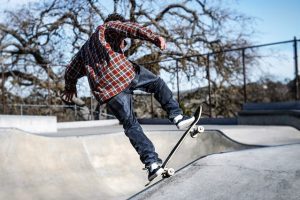We’ve all seen them – the fearless skateboarders cruising down city streets, school, or defying gravity at local parks. What we may not realize is that beneath the surface of this seemingly individualistic sport, there’s a rich culture of camaraderie and mutual respect.

Skateboarding park enthusiasts, as we know them, are part of a larger concept of extreme sports, which includes activities like snowboarding, BMX biking, motocross, and more. These sports require participants to have a combination of physical, technical, and motor skills, as well as confidence, interpersonal skills, and life skills.
In fact, skateboarding can be an incredible tool for problem-solving skills, motor skills, and interpersonal intelligence development. Over time, it helps build confidence and teaches participants about the dynamics of interaction in unique ways. Problem-solving helps you think deeper and smarter. The lessons learned from navigating skate parks can even foster empathy, respect among peers, resilience, and self-discipline. Furthermore, research suggests that skateboarding could have positive implications not only for physical health but for mental health too. The mental relational benefits and health benefits of skateboarding are good reasons for trying one.
Key Takeaways
- At FamilyHype, we understand the power of skateboarding and its potential to shape better like-minded individuals. We’ve seen how skateboarding can significantly boost social skills and mental health, making it more than just a sport, but a powerful tool for personal development. By encouraging kids to ride the skateboard, we’re helping them build confidence, understand social dynamics, and learn empathy, and respect.
- Skateboarding connections belong to the sports and recreation entity class and are comprised of three main aspects: physical activity, skill, and style. Physical activity of skateboarding includes core skateboarding maneuvers such as goal setting, pushing, flipping, and ollies.
- Skill encompasses the skills to maneuver and navigate around skateboarding obstacles as well as the aesthetic of new skateboard tricks. Skateboard style refers to the individual’s personal expression while skateboarding. Through mastering these skateboarding elements, skateboarders of all ages can benefit from improved balance, coordination, agility, and self-confidence.
- It’s important to remember that skateboarding is a sport and recreational activity that has the potential to shape better individuals and foster motor skills. Hence, skateboarding should be encouraged.
Understanding The Skating Community
You’re not just picking up a new hobby; you’re immersing yourself in a vibrant and tight-knit skate community that’ll embrace you with open arms, making you part of the rich skate tapestry. Understanding skateboard lingo, adhering to skatepark etiquette, and connecting with other riders while practicing tricks are key elements in this bonding process, fostering social connections, and enhancing communication skills. Even though some people view a skateboard as a simple wooden toy, it is more than that. This sport is something in which you can choose your own board design. You may also use it for various skate reasons, whether for transportation, recreation, or health purposes, all of which can enhance your skills and social interactions.
Skateboarding is more than tricks and boards; it’s about connection, respect, and the joy of mastering a skill. Building skateparks with the right attitude, you can use it to foster confidence, self-expression, and community involvement, further developing your abilities and social connections.
Skateboarding encourages community, unity, and fun.

Social Skills Connections And Enjoyment Through Skateboarding
- It is important to understand how skateboarding fosters social skills. Skateboarders have an enthusiasm for skateboarding that allows them to take risks, push their boundaries, and develop a sense of self-assurance. Aside from being able to enhance their problem solving skills, skateboarding encourages social relationships to be built through the community.
- Skateboarding is done at skateparks which provide a safe place for skateboarders to practice their skateboarding ability and socialize with other members of the community who share the same passion.
This article seeks to uncover the potential health benefits of skateboarding, as well as discover ways to leverage it for the development of interpersonal intelligence. We encourage our readers to share their own experiences and opinions around the topic, as we dive into understanding these benefits and discovering ways to encourage growth through this thrilling pastime.
Building Confidence Through Riding Boards
Surprisingly, mastering a kickflip like Tony Hawk did or simply cruising down the street on wheels can significantly bolster your confidence. The journey of resilience includes overcoming fear with each new trick attempted, cultivating self-belief as we push beyond our comfort zones, learning patience from practicing and failing, developing grit, which is transferrable to other life challenges, and building a unique identity within the skateboarding community.
This newfound confidence then plays an integral role in interpersonal dynamics and is a great way for families to bond and find common ground, further enhancing their ability and social interactions. Skateboarding encourages you to expand your horizons and interact with people.
Tony Hawk, a legendary figure in skateboarding. Tony Hawk played a significant role in making this sport an integral part of the family unit, with many parents and children alike finding joy in the activity. Tony Hawk inspired many skaters that were once a beginner.
From boards, protective gear, and accessories to tips and tricks for getting started, FamilyHype is the go-to resource for riders of all ages and skill levels, helping them develop their ability and social connections.
Interpersonal Dynamics
- It’s an incredible feeling, isn’t it? The social connections formed through the interpersonal dynamics of skateboarding are truly special. Skateboarding encourages forming relationships with new people in your community. Friendships are forged and camaraderie is nurtured while skateboarding in skateparks. Further, the skatepark etiquette teaches us to respect each other’s space and time. The peer influence encountered while skateboarding shapes our social intelligence subtly yet profoundly.
- The younger skateboarders experience an incredible feeling as the skatepark transforms into a second home, where friendships are forged and camaraderie and support are nurtured while skateboarding. Skateparks foster contact with other people. It has a welcoming culture that embraces both young and old riders in one place.
- Skateboarding brings individuals together, regardless of their differences. Skateboarding is a powerful platform that allows for creative potential and creative expression. Riding skateboards can help foster a sense of belonging.
Teach Empathy And Respect
Ever noticed how the rhythmic sound of wheels on concrete can foster a deeper understanding of others? Skateboarding, a beloved activity, serves as an avenue for empathy exercises and respectful communication. It connects with a diverse community, fostering acceptance and collaboration. As we learn to respect unique styles and boundaries, riding boards become a tool for enhancing interpersonal ability. Along the way of your riding journey, you will definitely pick up life lessons.

As we use skateboarding to build understanding and respect, we hope it can be used to promote a healthy and fulfilling lifestyle. So, let us recognize skateboarding’s potential for fostering mental health resilience.
Improves Mental Health Of Kids
Shifting perceptions about skateboarding and its impact on mental health, we’ve discussed how it can significantly enhance interpersonal intelligence. Skateboard encourages you to go outside of the comforts of your house and mingle with different people.
Did you know that skateboarding not only builds interpersonal intelligence but also significantly boosts mental health?
- Engaging in skateboarding, an adrenaline-pumping activity, provides a valuable outlet for stress relief and promotes emotional well-being.
- Skateboarding teaches coordination, cognition, and flexibility. Riding skateboards benefit not just young skateboarders but skateboard users of all ages, enhancing their ability and interactions.
- Skateboarding improves kids’ mental health by providing support, positive impact, and fun ways to learn new skills and tips.
- Some even take to the skateboard as a form of therapy. Through skateboarding, they find solace and comfort in the rhythm of wheels hitting the pavement.
Stress Relief And Emotional Well-Being
At FamilyHype, we recognize the incredible potential of skateboarding to be used as a form of stress relief and emotional well-being. It’s more than just a sport, as its inherent physicality and mindfulness can help reduce stress levels and increase focus, promoting interpersonal ability. Being in the skatepark or this culture, skateboarding brings you many new friendships. Surrounding yourself in an environment where you can mingle with other children helps you relieve that stress, as opposed to staying at home.
Skateboarding making its Olympic debut has further highlighted its ability to release endorphins and provide an outlet for pent-up energy, creating a unique blend of exercise and peace while enhancing ability and interactions.
Riding Boards As A Therapy
Skateboarding is an incredibly therapeutic activity, with numerous mental and health benefits. From improving concentration to fostering resilience, it’s no surprise that skateboarding has become a go-to form of therapy for many.
Riding boards can be a positive therapy by helping people connect with communities and improve their mental and physical well-being.
With the help of skateboards, we can gain a better understanding of our physical and emotional abilities, as well as our limits. Aside from the communication aspects, it is our responsibility to continue to spread awareness about the therapeutic aspects of skateboarding and promote its use for mental and physical well-being.
Foster Intelligence Development
As we delve deeper into the world of skateboarding and its potential benefits, it’s important to discuss how we can actively foster interpersonal intelligence development through this thrilling sport. Problem-solving and decision-making are necessary in the sport, as you cannot succeed in your tricks if you do not practice these two. Skateboarding encourages you to think deeper.
- One of the most effective ways is by organizing skateboarding events that encourage interaction, teamwork, and community involvement. Skateboarding events make a great addition to class projects focused on developing emotional ability.
- Additionally, establishing skateboarding programs specifically for youth can provide a safe and structured environment where they can learn vital communication skills while indulging in their passion for street skating.
Organizing The Events
Pulling together a thrilling skateboarding event isn’t just about the flips and spins; it’s also a vivid canvas of interactions and connections being forged.
Identifying local businesses for partnerships, securing permits and insurance, planning interactive activities, marketing the event effectively, and nurturing relationships with sponsors – these are all integral components of a successful skateboarding event.
Youth Programs
Essential elements, such as skateboarding equipment, safety measures, and proper technique, are incorporated into our program to ensure that everyone learns how to ride responsibly as well as how to make sound decisions for their safety and the safety of their peers.
Conclusion
We’ve seen how skateboarding can significantly boost interpersonal intelligence and mental health. It’s not just a sport, but a powerful tool for personal development. By encouraging kids to ride the board, we’re helping them build confidence, understand dynamics, and learn empathy and respect. A young person can start learning with the guidance of an adult.
FAQs
Is Skating A Sport Or A Social Lifestyle?
Skateboarding is an action skating sport that has its roots in the United States and involves riding a skateboard and pulling off tricks. It is also a form of art, a career in the entertainment business, and a mode of transportation. If you choose to make it a part of your weekly skating routines, it may also be a skating lifestyle.
Is Skateboarding Harder With Girls?
Skateboarding is a physical activity in which both boys and girls can skate equally well. It requires physical strength and balance, and you can develop that with time. Girls are typically lighter than boys when skating, which can make it simpler to pop or flip a skate. When landing a skate trick, they are also less likely to shatter a skate.
Does Skateboarding Help With Other Sports?
Skateboarding can help you get more control and coordination if you’ve always felt a little clumsier than a normal person. The learning curve in skating can be challenging, but in the long run, you’ll benefit from having better coordination for multitasking, driving, other skate sports, and regular daily tasks. So, skate on!
Do Skateboarders Have Strong Pain Tolerance?
Skaters have a rather high pain threshold and skills, which makes it simpler for them to ignore their difficulties and maintain a denial about their skating existence. When their legs hurt, they adjust their board slightly or simply shake them slightly to make up for the discomfort. If you have a low pain threshold, you can always wear skateboarding protective equipment to avoid injury. Still, don’t be afraid that you’re going to fall when riding boards, it is part of the skateboarding training process.
Why Is Skateboarding The Hardest Sport?
One could classify skateboarding as a difficult sport. To advance in the sport of skateboarding, one needs a combination of agility, coordination, and perseverance. It can also be very harsh because failing frequently results in hitting concrete. For skate beginners, learning to skate even the most basic and new tricks can take months due to the skate sport’s extremely steep learning curve.
How Many Days Does Skating Take To Learn It?
Learning to do skateboarding takes a few days to a week, depending on your athletic prowess, time constraints, and dedication. Skateboarding involves years of practice; some people pick it up more quickly than others. Just know that whether it takes you longer to skate than most people, your time spent practicing to skate is not a waste. If you’re interested in being a professional skater like Rodney Mullen, just keep on doing you. Taking risks with skateboarding and determination is what matters in our lives. You can have your skateboarding practice on a nearby skatepark or other areas you are comfortable skating, as long as they’re safe and supervised by adults.
What Is The Skateboarding Culture?
Skateboarding has grown into a teenage subculture that values skate originality and skate ingenuity. Skating serves as a substitute for traditional team sports, which are more officially structured and predominately managed by skating adults.
Is Longboarding A High-Risk Sport?
According to scientific social studies in skating, skateboarding isn’t any more risky than other sports; nonetheless, there is a chance of damage that can be reduced by using the proper safety measures. Wear skateboarding safety gear, stick to the fundamentals, and think about taking a skateboarding lesson from a qualified skating instructor.
Is It Skateboarding A Gendered Sport?
Because primarily men engage in skateboarding, the activity has traditionally been dominated by men not just because it develops social skills but because it’s fun. Skaters are still overwhelmingly male, although there is an increasing number of female skaters. Skateboarding is a fun activity for everyone regardless of their gender or race.
How Many Hours Should Skaters Skate?
Try to do skateboarding 6 to 10 hours per week if you want to get better at skating. We advise spreading out the 1.5-2.5 hour skateboarding sessions over 3–4 days of the week. Avoid ice skateboarding for too long since you will get weary and start skateboarding erratically. Skate safely.
How Has The Evolution Of Skating Influence The World?
Is Skating Worth It?
What Safety Precautions Should Beginners Prioritize When Learning How To Ride Boards?
In What Ways Does Longboarding Serve As Self-Expression?
How I Learn To Ride With Friends?
Last Updated on July 2, 2024 by Raymond Sy Tamco
DISCLAIMER (IMPORTANT): This information (including all text, images, audio, or other formats on FamilyHype.com) is not intended to be a substitute for informed professional advice, diagnosis, endorsement or treatment. You should not take any action or avoid taking action without consulting a qualified professional. Always seek the advice of your physician or other qualified health provider with any questions about medical conditions. Do not disregard professional medical advice or delay seeking advice or treatment because of something you have read here a FamilyHype.com.